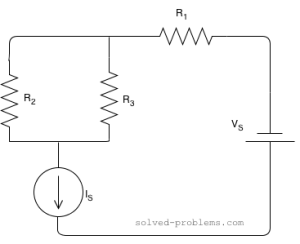Voltage Division
The voltage division rule (voltage divider) is a simple rule which can be used in solving circuits to simplify the solution. Applying the voltage division rule can also solve simple circuits thoroughly
Voltage Division Rule: The voltage is divided between two series resistors in direct
proportion to their resistance.
Example:
Solution:
the Ohm's law implies that
Applying KVL
Hence
i(t)=v(t)R1+R2 .
Substituting in I and II
v1(t)=R1v(t)R1+R2 ,
v2(t)=R2v(t)R1+R2 .
Consequently
v1(t)=R1R1+R2v(t) ,v
2(t)=R2R1+R 2v(t) .
CURRENT DIVISION
Current Division
A Current Divsion circuit is a circuit in which the main current from the power source is divided up in the circuit and, thus, different amounts of current are allocated to different parts of the circuit.
Example:

Suppose that R1=2Ω , R2=4Ω , R3=1Ω , IS=5A and VS=4V
Solution:
IR2=R3R2+R3×IS=11+4×5=1A
IR3=R2R2+R3×IS=41+4×5=4A .
IR1=IS=5A .
KCV around the loop assuming the positive terminal of the current source to be the one at bottom:
+VIS−R3×IR3−R1×IR1−VS=0
VIS=R3×IR3+R1×IR1+VS
VIS=1×4+2×5+4=18V
Solution:
IR2=R3R2+R3×IS=11+4×5=1A
IR3=R2R2+R3×IS=41+4×5=4A .
IR1=IS=5A .
KCV around the loop assuming the positive terminal of the current source to be the one at bottom:
+VIS−R3×IR3−R1×IR1−VS=0
VIS=R3×IR3+R1×IR1+VS
VIS=1×4+2×5+4=18V

Walang komento:
Mag-post ng isang Komento